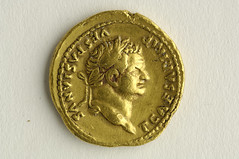
PREV ARTICLE
NEXT ARTICLE
FULL ISSUE
PREV FULL ISSUE
V11 2008 INDEX
E-SYLUM ARCHIVE
CURATORIAL TOURS OF PRINCETON'S RENAISSANCE NUMISMATICS EXHIBIT
Curator Alan Stahl forwarded this information about two
upcoming tours of an exhibit featuring antiquarian numismatic literature.
Included below are two illustrations Alan provided. The book is: Andrea
Fulvio, Illustrium imagines (Lyons: Antoine Blanchard, 1524); The coin is:
Rome, Titus, AD 79-81, gold aureus. -Editor
 Alan Stahl, Curator of Numismatics at Princeton
University, will give the final two curatorial tours of the exhibit
“Numismatics in the Renaissance” at the Firestone Library on Friday, May
30 at 2 p.m. and Sunday, June 1 at 3 p.m. The exhibit will remain on view
in Firestone’s Main Exhibit Hall through July 20.
Alan Stahl, Curator of Numismatics at Princeton
University, will give the final two curatorial tours of the exhibit
“Numismatics in the Renaissance” at the Firestone Library on Friday, May
30 at 2 p.m. and Sunday, June 1 at 3 p.m. The exhibit will remain on view
in Firestone’s Main Exhibit Hall through July 20.The exhibition includes rare fifteenth- and sixteenth-century volumes from Princeton’s Rare Books Division that discuss and illustrate ancient coins, and a display of some of the treasures of the Library's Numismatic Collection, featuring gold, silver, and bronze coins of Greece and Rome, as well as coins and medals of the Renaissance that were inspired by them. The exhibition also includes manuscripts, prints, and drawings from Princeton University collections and Pirro Ligorio's monumental map of ancient Rome, made in 1561.
 Although ancient coins were found throughout the
Mediterranean region in the millennium following the end of the Roman
Empire, it was only in Renaissance Europe that they began to be studied
systematically; reproductions appear in some of the earliest printed books
to carry engraved illustrations. The Princeton collection is particularly
rich in these impressive examples of early printing, ranging from the 1517
edition of Andrea Fulvio's Images of the Illustrious, with its highly
decorated settings of each coin image, through Hubert Goltzius's
large-scale chiaroscuro reproductions of imperial portraits of the 1550s,
to Antonio Augustín's late sixteenth-century systematic classification of
ancient coinage and guidelines for detecting counterfeits.
Although ancient coins were found throughout the
Mediterranean region in the millennium following the end of the Roman
Empire, it was only in Renaissance Europe that they began to be studied
systematically; reproductions appear in some of the earliest printed books
to carry engraved illustrations. The Princeton collection is particularly
rich in these impressive examples of early printing, ranging from the 1517
edition of Andrea Fulvio's Images of the Illustrious, with its highly
decorated settings of each coin image, through Hubert Goltzius's
large-scale chiaroscuro reproductions of imperial portraits of the 1550s,
to Antonio Augustín's late sixteenth-century systematic classification of
ancient coinage and guidelines for detecting counterfeits.The role that the study of ancient coins played in Renaissance culture is illustrated through the display of art works of the period that depict objects of classical antiquity, most notably a drawing by Parmigianino in the collection of the Princeton University Art Museum with an image of the goddess Minerva apparently derived from one on Roman coins. Selected Renaissance coins and medals will highlight the efforts of rulers of the period to present themselves in the guise of ancient leaders. Coin imagery in Renaissance literature will be shown by the pairing of Tudor coins with early editions of Shakespeare's history plays, which are particularly rich in puns on coin names and details.
"Numismatics in the Renaissance" is free and open to the public. Gallery hours are weekdays from 9 a.m. to 5 p.m., plus Wednesday evenings until 7:45 p.m., and Saturdays and Sundays from noon to 5 p.m.
Wayne Homren, Editor
The Numismatic Bibliomania Society is a non-profit organization promoting numismatic literature. See our web site at coinbooks.org.
To submit items for publication in The E-Sylum, write to the Editor at this address: whomren@gmail.com
To subscribe go to: https://my.binhost.com/lists/listinfo/esylum
All Rights Reserved.
NBS Home Page
Contact the NBS webmaster
